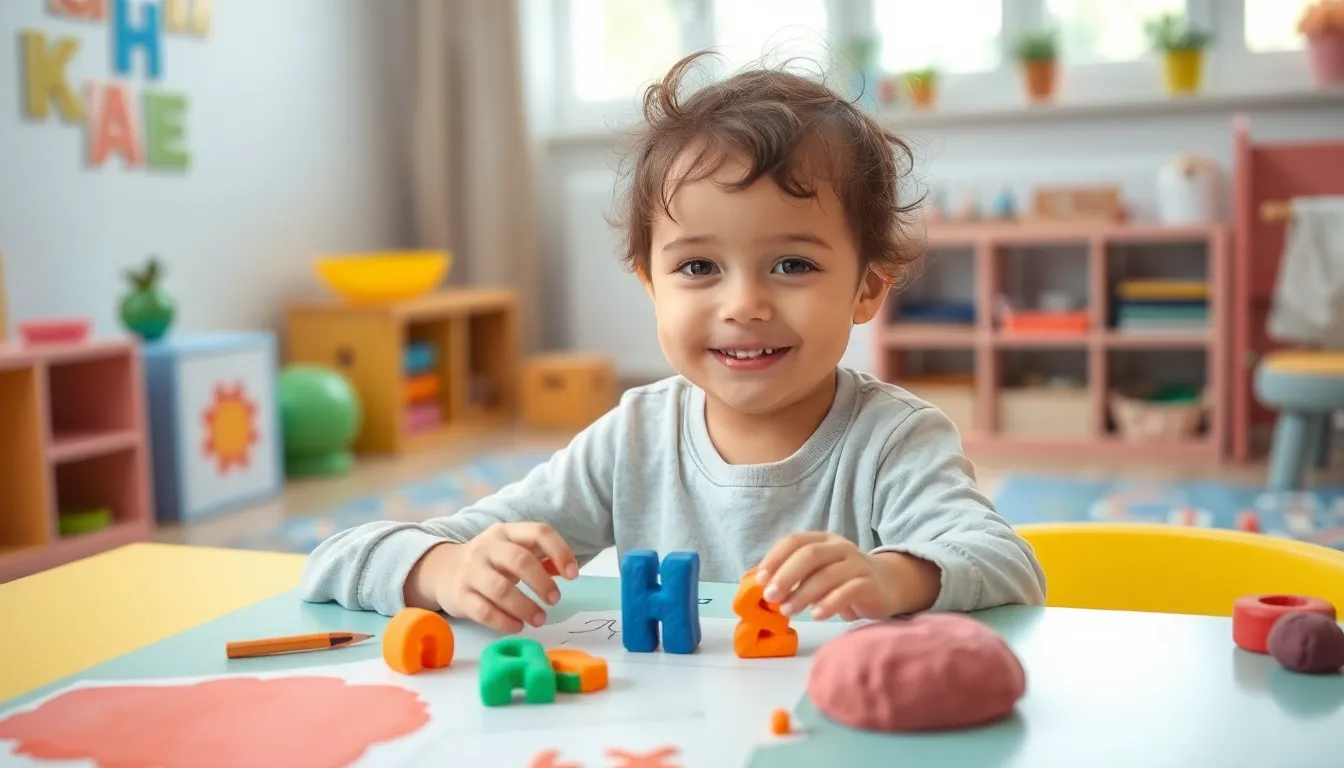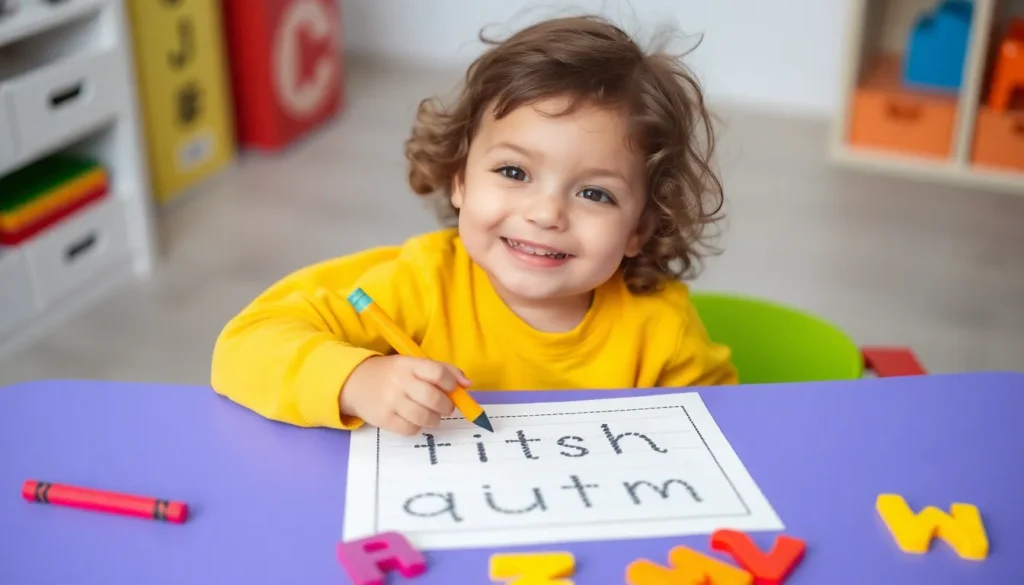Letter tracing for toddlers isn’t just about preparing little ones for school; it’s a playful adventure that sparks creativity and builds confidence. Imagine a world where letters come alive, dancing across the page as tiny fingers trace their shapes. This magical journey not only helps kids learn the alphabet but also gives them a chance to unleash their inner Picasso—minus the paint splatters!
As toddlers dive into letter tracing, they develop fine motor skills and hand-eye coordination. Plus, it’s a sneaky way to keep them engaged while sneaking in some educational fun. So grab those colorful crayons and let the tracing begin! Who knew learning could be this entertaining?
Table of Contents
ToggleBenefits Of Letter Tracing For Toddlers
Letter tracing offers multiple advantages for toddlers. Engaging in this activity supports early learning while making it enjoyable.
Enhancing Fine Motor Skills
Fine motor skills play a critical role in a toddler’s development. Tracing letters requires precise hand movements, strengthening the small muscles in their fingers and hands. Each stroke encourages better grip control as toddlers practice coordination. Holding crayons or pencils while tracing assists in developing dexterity. Improved dexterity leads to enhanced control for tasks like writing and drawing. Parents can incorporate fun tools, such as textured tracing sheets, to capture the child’s interest.
Boosting Letter Recognition
Letter recognition forms the foundation of reading and writing. When toddlers trace letters, they become familiar with their shapes. Associating letters with sounds occurs naturally through repetition during tracing activities. This practice creates a strong visual memory, aiding in quicker identification of letters. Engaging in this activity also helps toddlers connect letter shapes to the sounds they represent. Use colorful letters to make the tracing experience appealing and memorable for young learners. Tracing reinforces both visual and auditory associations, laying a strong groundwork for literacy development.
Activities To Encourage Letter Tracing

Engaging toddlers in letter tracing activities improves their motor skills and prepares them for future learning. Several creative options exist to make tracing enjoyable.
DIY Letter Tracing Tools
Parents can create tracing tools using materials found around the house. Utilize sandpaper or textured paper to help toddlers feel the shape of each letter. This tactile experience reinforces muscle memory. Additionally, using whiteboards with dry-erase markers allows for easy correction and repeated practice. Create colorful letter cards for toddlers to trace with their fingers, encouraging recognition through touch. Lastly, paint on a large surface with finger paints, providing a fun, free form of letter tracing while promoting creativity.
Fun Tracing Exercises
Incorporate tracing exercises that combine play and learning. Use play dough to form letters, emphasizing the shape and structure. Offer worksheets with dotted letters, making it easy for toddlers to trace individually. Drawing letters in sand or rice gives a sensory experience while learning. Sing songs that focus on the alphabet as toddlers trace letters, strengthening association through sound. Throw in games like letter scavenger hunts, where toddlers find and trace letters around the house. These activities enhance engagement while developing essential skills.
Choosing The Right Materials
Selecting the right materials enhances the letter tracing experience for toddlers. Numerous options exist that cater to different learning styles.
Worksheets And Printable Resources
Worksheets and printable resources provide structured tracing opportunities. Many websites offer free downloadable templates featuring dotted letters for tracing. Various designs engage toddlers with fun themes, like animals and colors, ensuring interest stays high. Parents can also create customized worksheets, tailoring difficulty levels to suit their child’s developmental stage. Access to diverse tracing sheets boosts practice and reinforces letter recognition, helping toddlers associate letters with their shapes.
Digital Apps For Letter Tracing
Digital apps offer interactive letter tracing experiences that captivate toddlers. Many apps feature colorful graphics and engaging animations, making learning enjoyable. Some provide step-by-step guidance, ensuring toddlers develop correct letter formation. Advantages of the digital format include instant feedback, allowing children to recognize mistakes and correct them immediately. Various educational platforms offer free and paid app options, catering to different budgets while enriching the tracing experience.
Tips For Parents
Engaging toddlers in letter tracing can be enjoyable and effective with the right approach. Creating a supportive atmosphere encourages children to explore and learn.
Creating A Positive Learning Environment
Fostering a positive learning environment starts with minimizing distractions. Organizing a dedicated space with bright colors and engaging visuals can spark interest. Using comfortable seating allows toddlers to focus better. Parents can encourage exploration by celebrating small achievements during tracing exercises. Listening to cheerful music may create a more stimulating atmosphere. Selecting materials like textured paper enhances sensory experiences, making learning memorable. Keeping the mood light, using laughter and encouragement, fosters confidence in young learners.
Incorporating Letter Tracing In Daily Activities
Incorporating letter tracing into daily activities brings learning into everyday life. Parents can transform routine tasks into educational moments, such as writing letters during grocery shopping. Involving toddlers in cooking by tracing letters on recipe cards blends fun and learning seamlessly. Using the alphabet in storytelling engages children while encouraging letter recognition. Playful activities like tracing letters in the sand at the beach create memorable experiences. Integrating tracing into art projects, such as creating signs or cards, expands creativity while reinforcing skills. Additional ideas include labeling household items, which helps toddlers associate letters with real-world objects.
Letter tracing offers a playful and effective way for toddlers to develop essential skills. By engaging in this activity, children enhance their fine motor skills and letter recognition while having fun. Incorporating creative tools and varied activities keeps the experience fresh and exciting, ensuring that learning remains a joyful journey.
Parents play a crucial role in fostering a supportive environment that encourages exploration and celebration of progress. By integrating letter tracing into daily routines and using diverse materials, they can help their toddlers build a strong foundation for literacy. Ultimately, the combination of creativity, engagement, and consistent practice makes letter tracing a valuable part of early childhood education.






